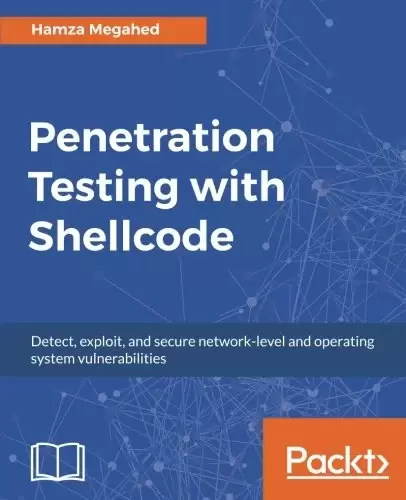
Book Description
Penetration Testing with Shellcode: Detect, exploit, and secure network-level and operating system vulnerabilities
Master Shellcode to leverage the buffer overflow concept
Key Features
- Understand how systems can be bypassed both at the operating system and network level with shellcode, assembly, and Metasploit
- Learn to write and modify 64-bit shellcode along with kernel-level shellcode concepts
- A step-by-step guide that will take you from low-level security skills to covering loops with shellcode
Book Description
Security has always been a major concern for your application, your system, or your environment. This book’s main goal is to build your skills for low-level security exploits, finding vulnerabilities and covering loopholes with shellcode, assembly, and Metasploit.
This book will teach you topics ranging from memory management and assembly to compiling and extracting shellcode and using syscalls and dynamically locating functions in memory. This book also covers techniques to compile 64-bit shellcode for Linux and Windows along with Metasploit shellcode tools. Lastly, this book will also show you to how to write your own exploits with intermediate techniques, using real-world scenarios.
By the end of this book, you will have become an expert in shellcode and will understand how systems are compromised both at the operating system and network level.
What you will learn
- Create an isolated lab to test and inject shellcodes (Windows and Linux).
- Understand both Windows and Linux behavior.
- Learn the assembly programming language.
- Create shellcode using assembly and Metasploit.
- Detect buffer overflows.
- Debug and reverse-engineer using tools such as GDB, edb, and Immunity (Windows and Linux).
- Exploit development and shellcodes injections (Windows & Linux).
- Prevent and protect against buffer overflows and heap corruption.
Who This Book Is For
This book is intended to be read by penetration testers, malware analysts, security researchers, forensic practitioners, exploit developers, C language programmers, software testers, and students in the security field.
Readers should have a basic understanding of OS internals (Windows and Linux). Some knowledge of the C programming language is essential, and a familiarity with the Python language would be helpful.
Table of Contents
Chapter 1. Introduction
Chapter 2. Lab Setup
Chapter 3. Assembly Language in Linux
Chapter 4. Reverse Engineering
Chapter 5. Creating Shellcode
Chapter 6. Buffer Overflow Attacks
Chapter 7. Exploit Development – Part 1
Chapter 8. Exploit Development – Part 2
Chapter 9. Real-World Scenarios – Part 1
Chapter 10. Real-World Scenarios – Part 2
Chapter 11. Real-World Scenarios – Part 3
Chapter 12. Detection and Prevention
中文:
书名:Penetration Testing with Shellcode
使用外壳代码进行渗透测试:检测、利用和保护网络级和操作系统漏洞
利用缓冲区溢出概念的主外壳代码
Key Features
- 了解如何通过外壳代码、汇编和Metasploit在操作系统和网络级别绕过系统
- 学习编写和修改64位外壳代码以及内核级外壳代码的概念
- 这是一个循序渐进的指南,将带您从低级安全技能到用外壳代码覆盖循环
图书描述
安全性一直是您的应用程序、系统或环境的主要关注点。这本书的主要目标是建立您的技能为低级别的安全漏洞,发现漏洞,并掩盖漏洞外壳代码,汇编和Metasploit。
这本书将教你从内存管理和汇编到编译和提取外壳代码以及使用syscall和在内存中动态定位函数的各种主题。本书还介绍了编译用于Linux和Windows的64位外壳代码的技术,以及Metasploit外壳代码工具。最后,这本书还将向您展示如何使用实际场景,使用中间技术编写您自己的漏洞。
到本书结束时,您将成为外壳代码方面的专家,并将了解系统如何在操作系统和网络级别受到危害。
你将学到什么
- 创建一个独立的实验室来测试和注入外壳代码(Windows和Linux)。
- Understand both Windows and Linux behavior.
- Learn the assembly programming language.
- 使用汇编和Metasploit创建外壳代码。
- 检测缓冲区溢出。
- 使用GDB、EDB和免疫(Windows和Linux)等工具进行调试和反向工程。
- 利用开发和外壳代码注入(Windows和Linux)。
- 防止缓冲区溢出和堆损坏。
这本书是为谁写的
本书面向渗透测试人员、恶意软件分析师、安全研究人员、法医从业者、漏洞利用开发人员、C语言程序员、软件测试人员和安全领域的学生。
读者应该对操作系统的内部结构(Windows和Linux)有一个基本的了解。C编程语言的一些知识是必不可少的,熟悉Python语言会很有帮助。
目录表
Chapter 1. Introduction
第2章.实验设置
Chapter 3. Assembly Language in Linux
第4章:逆向工程
第5章.创建外壳代码
第6章.缓冲区溢出攻击
第7章.利用开发-第1部分
第8章.利用开发-第2部分
第9章.真实世界场景-第1部分
第10章.真实世界场景-第2部分
第11章.真实世界场景-第3部分
第十二章.检测和预防
评论前必须登录!
注册